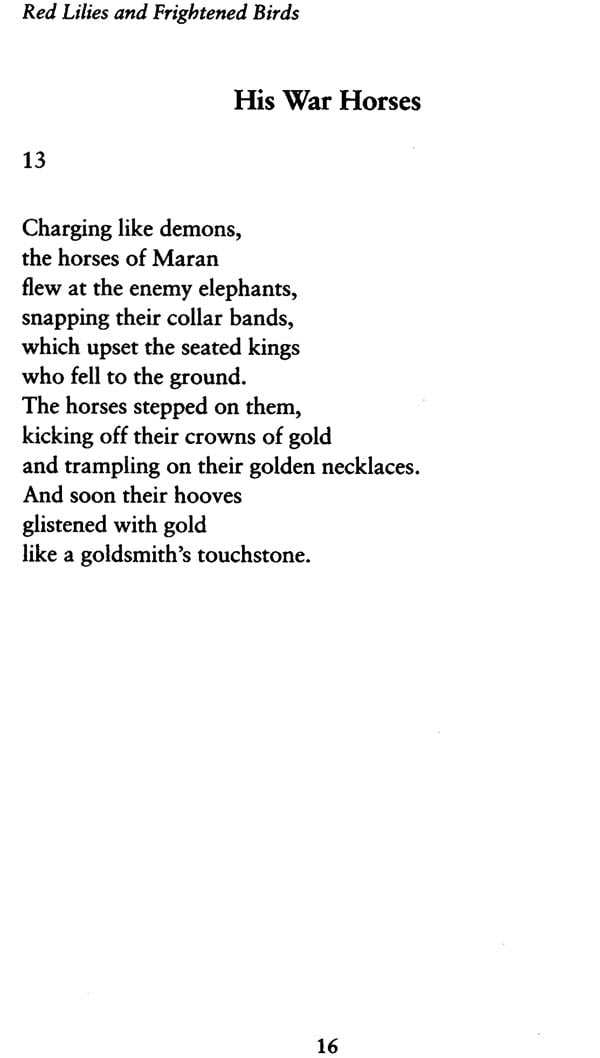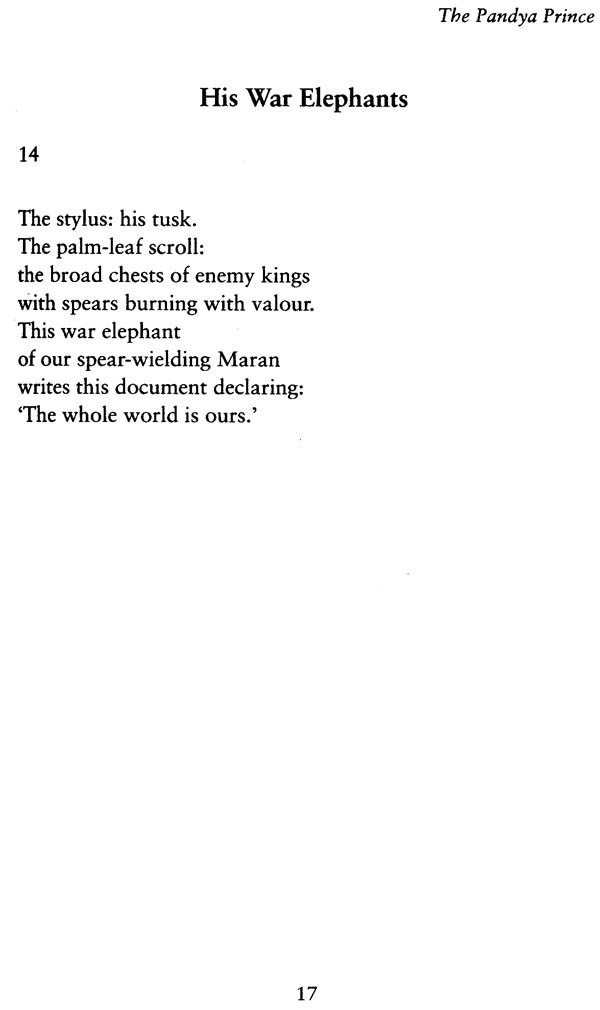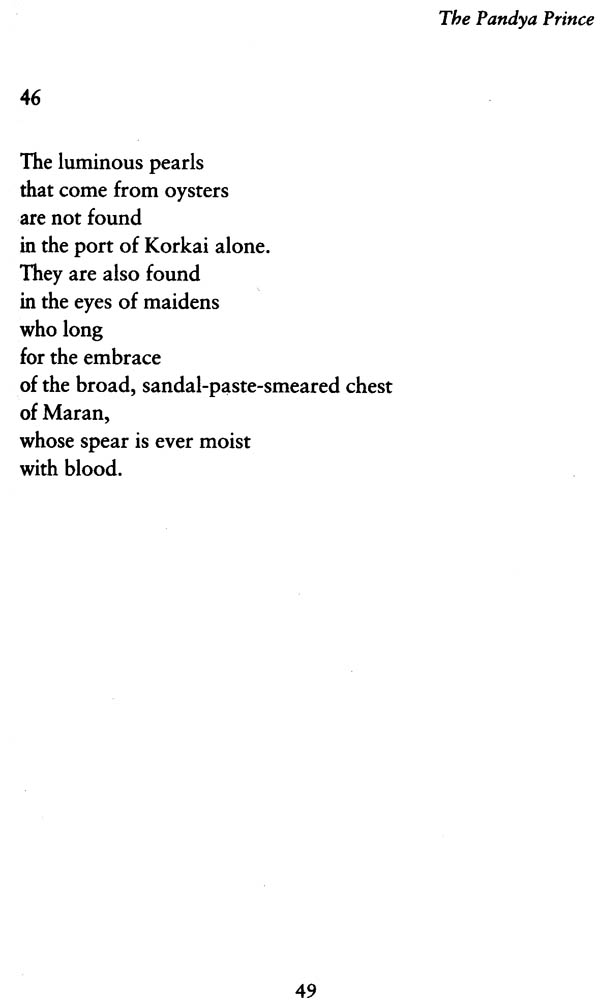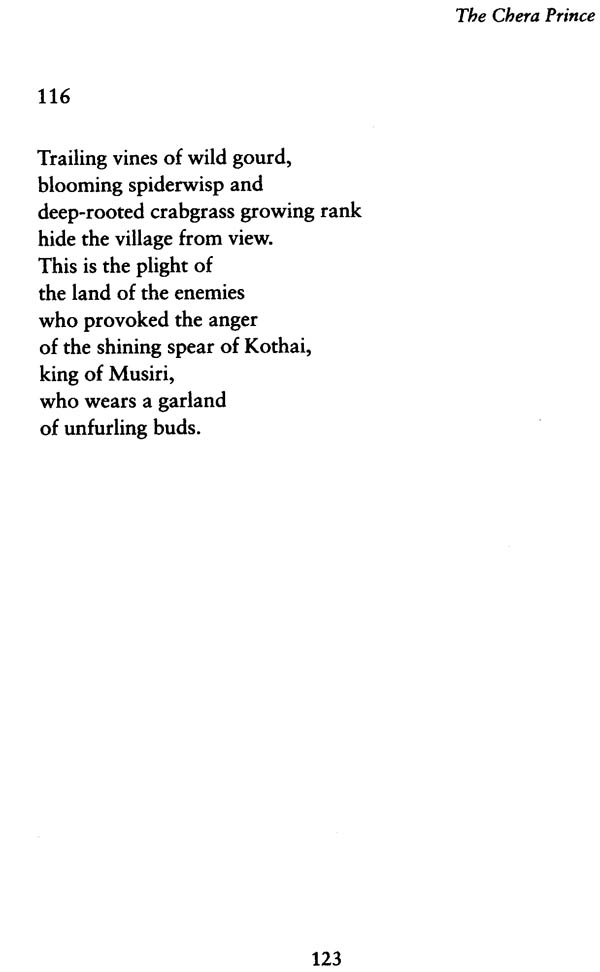
Red Lilies and Frightened Birds
Book Specification
| Item Code: | NAI209 |
| Author: | Muttollayiram |
| Publisher: | Penguin Books India Pvt. Ltd. |
| Language: | English |
| Edition: | 2011 |
| ISBN: | 9780143064855 |
| Pages: | 174 |
| Cover: | Paperback |
| Other Details | 7.5 inch x 5.0 Inch |
| Weight | 140 gm |
Book Description
That Tamil is a classical language is now a commonplace in the scholarly world. However, its living and unbroken literary tradition of over two millennia remains unrecognized to a large extent. Widely anthologized and translated, Tirukkural and Sangam poetry have come to stand for the entire corpus of classical Tamil poetry and didactic wisdom. In truth, the Tamil poetic tradition has much more to offer. With its brilliance and variety Muttollayiram presents an ideal text from which to launch further poetic forays into the landscape of Tamil poetic imagination.
Literally. Muttollayiram could mean either ‘three nine- hundred (of poems)’ or ‘nine hundred (poems) on the three (monarchs)’. Unfortunately, given the fact that only some 130 of them survive, the numbers themselves are a subject of another debate, and even the meaning of the ambiguous title has evoked considerable controversy. For a long time it was thought that Muttollayiram consisted of 2,7000 poems with 900 on each monarch-an erroneous view that some hold on to even now. However, even by the standards of Tamil’s bad luck where a large corpus of writings has been wiped out by calamities such as tsunamis, bigotry, and apathy, it is somewhat far-fetched that only about the actual numbers was ultimately cleared by S. Vaiyapuri Pillai, the enormously erudite if controversial scholar, who cited two grammatical texts, Llakkama Vilakka Pattiyal and Prabandha Deepikai, which refer to a genre called ‘Thollayiram’ that consists of 900 poems.
Therefore, it is now clear that Muttollayiram consists of 900 poems in all, with 300 each devoted to a monarch hailing from one of the three dynastics-cheras, cholas and Pandays. The bulk of them ( 108 plus an invocatory poem) come from a fifteenth-century anthology of Puram Poems, Purathirattu; quotations from medieval commentaries account for the rest. Poems from Muttollayiram have been cited or quoted in a variety of pro-colonial commentaries of mostly grammatical texts, indicating its continued importance in Tamil literary culture. It is evident that Muttollayiram is not an anthology but a unified work by a single author who, however, is anonymous, with neither written record nor even oral tradition to throw a single shaft of light upon his identity. Like all Tamil literary texts, the dating of Muttollayiram is a subject of debate. Based on internal and external evidence, S. Vaiyapuri Pillai dated to the early part of the ninth century CE while T.V. Sadasiva Pandarather dated is more plausible.
It was not until 1905 that these poems were first culled from Purathirattu by Ra. Raghavaiyangar and published separately. The credit for drawing attention to the exquisite poetic qualities of Muttollayiram and celebrating it should go to T.K. Chidambaranatha mudaliar (1881-1954), the renowned connoisseur of poetry. Since then, despite their meager quantity, these poems have captured the hearts of the cognoscenti and been frequently reprinted and glossed. Muttollayiram has also been translated at least twice into English—P.N.Appuswami (1997) and A.V Subramanian (1984); into Sanskrit—A.V. Subramanian (1993); and into Hindi—S. Subramanian (1996). There is also a German study of the text by Ulrike Niklas (1987).
Why should this book of hundred-odd poems, admittedly incomplete, capture the fancy of Tamil readers and warrant a new English translation? Readers familiar with Sangam poetry will easily recognize the setting and the themes of Muttollayiram. The conventions of akam and puram mingle almost seamlessly, extending the elaboration of Sangam themes to their limits.
Coming centuries after the flowering of Sangam poetry, the earliest corpus of Tamil literature, Muttollayiram nevertheless presents much continuities. The chera, Chola, Pandya kings, who are even mentioned in the second and thirteenth rock edicts of Ashoka (third century BCE), and still somewhat nascent in the Sangam age, emerge in Muttollayiram as full monarchs in all their glory. A number of terms for rulers—such as irai, ko, kilavan, velar, kurisil, kottram, mannan, arasu, and ventar-occur in the more ancient corpus dated to the cusp of the common Era. The usage of these terms, the Marxist Tamil scholar K. sivathamby observes, is often marked by considerable flexibility; but this flexibility ‘is seen only in the case of those who go high up in the ladder of the authoritative position’. Despite plausible arguments that ‘there is nothing, whether in literature, epigraphy or archaeology, which points to the institution of the state in that society’. It is, however, evident that the ventar are clearly distinguished from the lesser kings/chieftains; referring to monarchs, this term is used to the most powerful and militaristic personally of the rulers to emerge in Tamilnadu.’ As K.Kailasapathy states, the term muventar was ‘ exclusively and collectively used by the bards of the [Sangam] Anthology poems for these three kings. Hence the term has come to have a specific meaning o f “crowned heads”. He adds that this phrase ‘has a rich literary usage behind it. Further, as Sivathamby says, the ‘tradition of referring to the other two [monarchs] when eulogizing the third’ is also very common.
The three royal lineage of antiquity—Chera, Chola, and Pandya—are extolled in 138 poems of Purananuru, the Sangam anthology of four hundred puram poems. Muttollayiram refers to them by a variety of titles (some probably dating from their pre-monarchic past): the Pandya is called Makadumkone’, ‘Maran’, ‘Koodal Koman’. ‘Thennan’, ‘Cheliyan’ and ‘Valudi’; the Chola is referred to as ‘Valavan’, ‘Sembian’, and ‘Killi’; and the Chera is addressed as ‘kothai’, ‘ Vanchi Ko’, ‘mandhai Ko’ and Vanavan’. On the other hand, the teeming scores odf valorous and proud chieftains and local tribal chiefs in Sangam poetry –praised in as many as 141 Purananmuru poems (and thus outnumbering the panegyrics on the monarchs)—appear only as enemies to be routed or as vassals heaping tributes at the monarchs’ feet. The tragic story of Pari, the munificent chieftain of the Parambu mountain country, who is treacherously defeated by the joint action of the three momarchs in a protracted siege and is hero of many a Purananuru poem, would be out of place in Muttollayiram.
Further, it is very interesting to note that the three monarchs are not mentioned in Muttollayiram by name at all but identified by their dynasty and related titles. A unified conception of the Tamil country ruled by the three traditional dynasties animates the text. Even in Purananuru, we have references to Tamilakam (the Tamil country) which the monarchs aspire to bring under their rule. The continual feuds among the monarchs not with standing, a unified conception of the three kingdoms constituting a single Tamil country was present at least in the minds of poets. The celebrated Silappadhikram takes the name of each of its three cantos from the capitals of the muventar: Pukar. Madurai and Vanchi. It would appear that Muttollayiram is following this tradition by having odes to the three monarchs in a single work. Further, we also have two surviving instances where tha Chola and Pandya kings are referred to as Tamilar/Tamilar peruman ( lord of the Tamil people.
Of each monarchs, the glory of his country and city, the military adventures of his horses and elephants, his prowess in war, the exploits of his weapons and the ruining of the enemy country—themes familiar from Purananuru—are elaborated by Muttollayiram in great poetic detail and hyperbole. The royal insignia, listed as befitting the ‘sceptred monarchs’ in Tholkappiyam, the great 2000-years-old Tamil grammatical treatise, im its chapter on peotic conventions—‘army, flag, parasol, drum, horse, elephant, charior garland, crown’—find adequate mention in these poems.
But over three-quarters of the Muttollayiram poems speak of how nubile women, deeply infatuated, pine and long for the king. Bangles slip from wrists become thin with lovesickness, while the skin develops patches in lovesick pallor—the consummation taking place only in dreams rather than in reality as the women yearn for the king marching past on his elephant or horse in ceremonial procession. The prudish mother and foster mother who do their best, but in vain, to stop the heroine from indulging in her love, and the helpful go-between, her friend—the familiar dramatis personae from akam poetry—figure here very prominently. As a majority of the poems may be classified as Kaikkilai, the theme of one –sided and unrequited love, it is not surprising that they are all in the voice of the lovelorn girl. There are also some poems in the words of the mother/foster mother. Perhaps mot a single theme would be unfamiliar to a reader of Sangam poetry.
In a little-noticed essay, K. Sivathamby argues that political authority in early Tamilnadu was ‘inchoate’ and goes on to assert that ‘a highly personalized monarchy had arisen in[early] Tamilnadu’. A fascinating chapter in Kesavan Veluthat’s study of the political structure of early medieval south India analyses what he calls ‘the self-image’ of this ‘personalized’ monarch:
Several aspects went into the making of this image—origin myths, dynastic traditions, generalogies, etc. through which the dynasty in general sought legitimation as well as through the presentation of an individual king as having acquired ksatriya status, as chakravartin, as a warrior hero, as a protector and fountain-head of all dharma, as a munificent donor, as a divine figure, as an attractive mien, and family as patron of arts and culture.
Going into the origins of these constructive elements of the fashioning of this self-image, Veluthat adds :< p> While most of these aspects were inspired by stereotypes presented in Sanskrit literature, these were aspects which has an equally local, Tamil bearing which took into account traditions of the Sangam literature concerning dynastic connections and also myths about individual ancestors and culture centers.
What accounts for Muttollayiram’s continuing fascination? Firstly, Muttollayiram is written in the venba metre, a quatrain verse form with three lines of four feet each and a last line of three feet with a formulaic ending. A demanding prosodic form, venba has been likened to dancing with mancles on. The author of Muttollayiram is a crafty wielder of tha venba, masterpiece. This would certainly mean much to a native reader of the poetry, but is impossible to reproduce in translation. (Y. manikandan has argued that the venba used in Muttollayiram is still evolving and therefore suggests this as another ground for assigning an early date to the text.)
This formalistic justification apart, the genius of Muttollayiram lies in fusing akam and puram conventions in an original—in both senses of the term, of being the first and being new –way. Tholkappiyam, the paradigmatic Tamil grammatical treatise that codifies not only eluthu (letter—phonetics) and Chol( word—morphology and syntax) but also porul(content—poetics or rhetoric), is particularly strict in defining and segregating the two complementary and overarching categories of akam and puram. Akam, the inner, is all about love and conjugality. And puram, the outer, is concerned with everything in the world excepts akam. Akam conventions are in turn strictly defined. Any reference to an actual person or even an identifying allusion would render a poem—akam in every other respect—a puram one. And of love too, only the five classical love situations are acknowledged as worthy of akam status. These are Kurinji (which tells of clandestine meetings of the lovers set in the hills); Mullai (narrating the hopeful waiting of the man and the sulking of his wife, set in the plains); Neidal (of the Wife’s anxious anticipation for the husband’s return in the littoral tracts); and Palai (of the lover’s departure and travel in search of wealth, education or adventure, set in the wilderness). On the other hand, Kaikkilai, one-sided or unrequited love, and Perumthinai, mismatched love or excessive lust, fall in the puram category.
By the definition of Tholkappiyam, all the love poems of Muttollayiram would fall only in the Kaikkilai category, thus accounting for their inclusion in Purathirattu, the anthology of puram poems. But this is not the sangam age—though we are not sure how many centuries later it is. However, Muttollayiram is unique in giving a rounded picture of secular figures, the monarchs, portraying not only their martial prowess but also their amorous exploits. The representation of the mu ventar, the three monarchs, in Muttollayiram has lingered long and imprinted itself in the Tamil psyche.
Thus Muttollayiram marks a new phase in Tamil literary tradition, bridging, as it were, Sangam and post-sangam poetic traditions. If Sangam poetry is a corpus with its own cosmology where one poem makes full sense only in realation to the entire body of writings, Muttollayiram handless many Sangam akam and puram themes wi=th abandon and flourish without too many of these restrictions and constraints of diction, Muttollayiram explores sangam themes intensively and extends them to the full, indulging in controlled exaggeration and understand hyperbole, while Muttollayiram, like sangam poetry, uses a few fixed epithets and noun epithets, usually for prosodic reasons, its genius lies in the noun epithets, usually for prosodic reasons, its genius lies in the almost infinite improvisations it makes in set themes.
Enemies,
Throw open the doors
Of yours castles!
Set free your elephants and horses
From their trappings of war!
For today,
The day of Uthiradam,
Our southern lord,
Great charioteer,
Celebrates his birthday,
And he will not fight today.
Here in Muttollayiram 7, we find the poet offering a reprieve to the enemies on the day of the Pandya king’s birth star: if purananuru 20 Talks of the Chera king, Mantharancheral Irumporai, who is the protector of all his subjects:
People who live under your canopy
Know no other fire
Than the fire of the cooking stove.
They know no other bow
Than the rainbow.
And no other weapon than the plough.
Putting down your powerful foes you have consumed their soil,
But your own soil
Is never consumed by anyone else
Except pregnant women
Who have morning sickness.
Your fort stands against arrows.
Your scepter stands for righteousness.
In spite of new ill-omens coming
And old ill-omens going
Your land is the safest haven for your people.
You are such a noble ruler,
The whole world fears for your safety.
Muttollayiram extends it to the inanimate:
The land of Kothai,
Deft wielder of a deadly speat,
With poison-tipped,leaf-shaped head,
Knows no tunmoil
Except that caused by the water birds.
For when the red lilies
Bloom in the waterlogged fields,
The birds panic,
Thinking the water is on fire.
They fly helter-skelter,
Trying to guard their nestlings
Under their wings.
If sangam poetry has very little to say about the prowess of the war horses and elephants, Muttollayiram is most elaborate in its description of their exploits.
Charging like demons,
The horses of Maran
Flew at the enemy elephants,
Snapping their collar bands,
Which upset the seated kings
Who fell to the ground.
The horses stepped on them,
Kicking off their crowns of gold,
And tramping on their golden necklaces,
And soon their hooves
Like a goldsmith’s touchstone.
If Muttollayiram’s handling of puran themes is brilliant, akam themes shine even better. The boundless flair for improvisation that these seem capable of –vividly invoking the travails of the lovelorn women pine for the monarch on ceremonial procession—is staggering.
Dear friend,
With slender arms
Full of bangles
And eyes like swords,
Let me ask you
One thing about my mother
Who forbids me
To look art Maran—
Who has conquered
Many a land,
Who wields
Flaming battle-hungry spears
And who wears garlands of
Fresh-blown flowers—
Had she never been young?
A more effective denunciation of the prudish mother who tries to prevent the heroine from looking at the king would be hard to conceive, or so one would think, but poem 117 probably outdoes this:
Look at the doors in this street!
All have worn-out hinges.
For mothers keep shutting them
And daughters keep throwing them open.
This happens whenever the prince kothai,
Wearing fresh flower garlands
And riding a sturdy horse,
Passes along the street
And love-mad girls
Rush to have a glimpse of him.
It is such prolific creativity in the variations of themes, one better than the other, that is the hallmark of Muttollayiram. In tribute, perhaps, later have taken them up—as, for instance, Kalingathupparani does in playing on the idea of worn-out hinges. In fact, a distinct genre, the Ula, emerges in the early part of the second millennium where the poem itself is structured around the ceremonial procession of the monarch, and the deity. Thus Muttollayiram also presages some later-day genres.
Ultimately poems, whether original or translated, have to stand by themselves without the crutches of introductions and glosses. M.L. Thangappa is ideally suited to the task as he is a consummate interpreter and translator of Tamil poetry into English.
Born in Kurumpalapperi, a small village in tirunelveli district—not far the mythical birthplace of Tamil pandits. The Pothikai hills—Thangappa comes from a family of Tamil Pandits. Thangappa’s father and at least two of his uncles were Tamil teachers. A somewhat precocious child, he could recite scores of Tamil poems when barely a boy. (This immersion in Tamil verse at an impressionable age has had a very peculiar effect on his prosodic skills. His keen ear can always detect minor variations or improvisations in metric forms even when not being able to actually name them.) When Thangappa went to the then venerable St John’s College, Palayamkottai, his grasp of idiomatic English, already imbibed from reading English fiction, was further buttressed by reading the Bible and the Romantic poets, taught by learned teachers including European clergymen who lectured there. As a Tamil teacher for over twenty-five years, lecturing at various colleges of the Puducherry government, classical Tamil Literature has been staple of his teaching, parsing and interpreting the terse poems for generations of students.
The range of his translations is staggering. From sangnam literature to Bharati and bharatidasan, Thangappa has translated a considerable body of Tamil literary texts into English over the last five decades. Ever the perfectionist, he always maintains that their his translations are incomplete—something that explains why many of them have not yet found their way into print. His belief that selections rather than full translations are better recommended has not particularly helped in remedying this situation. This is probably the first time that he has translated a full text—which also speaks for the brilliance of Muttollayiram. Despite his vast reading Thangappa is no pedant, preferring to rely on intuition rather than scholarship. If his car for English is astonishing, his grasp of Tamil is almost incredible. Unlike many translators—both renowned and not so renowned—who rely on commentaries, old and new, to get to a text, Thangappa reads classical Tamil like one would the morning newspaper.
Given Muttollayiram’s theory of recovery into print, as outlined above, a note on the edition used for this translation is in order. Purathirattu, from which Muttollayiram is drawn, is grouped under various puram themes—a scheme followed by the first editor of Muttollayiram, Ra. Raghavaiyangar (originally published as an appendix to the literary monthly Sentamil, vol.3, no.3, 1905, with 105 poems; later reprinted separately as a book by Madurai Tamil Sangam in 1935 with the addition of another three poems recovered from a newly discovered plam-leaf manuscript). S.vaiyapuri Pillai’s 1938 edition of Purathirattu for the madras University Press, still the best provides 110 poems, including one poem in a highly mutilated form cited in the editorial introduction. T.K. Chidambaranatha Mudaliar’s edition (1943), intended for the connoisseur, follows its own scheme, given its editor’s quirks.
| Introduction: of Spears and Bangles | XI |
| Invocation | 1 |
| The Pandya Prince | 3 |
| The Chola Prince | 65 |
| The Chera Prince | 113 |
| Notes | 138 |
| Acknowledgements | 143 |













